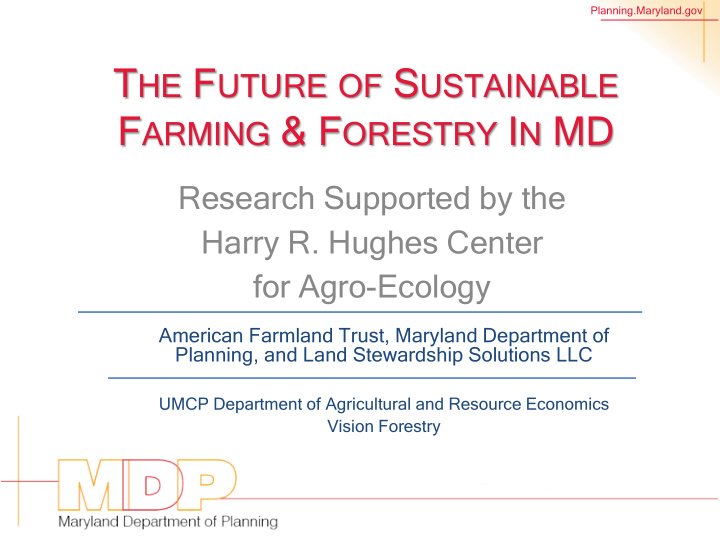



Planning.Maryland.gov T HE F UTURE OF S USTAINABLE F ARMING & F ORESTRY I N MD Research Supported by the Harry R. Hughes Center for Agro-Ecology American Farmland Trust, Maryland Department of Planning, and Land Stewardship Solutions LLC UMCP Department of Agricultural and Resource Economics Vision Forestry
Planning.Maryland.gov W HAT ’ S A T S TAKE Large sectors of MD’s rural economy • Farming: $2.3 billion sales, $4.7 billion direct output, over 22,000 jobs, $2.03 billion indirect and induced impacts • Forest products: $1.2 billion for materials, $2.3 billion shipments, $1.1 billion value added, $43 million capital expenses, 10,000 jobs for $650 m Food security & environmental/ ecosystem services
Planning.Maryland.gov K EY Q UESTIONS 1. What’s sustainability? 2. Where are farming & forestry headed under existing trends in markets, profitability? 3. Effects of environmental & smart growth policies? 4. Can policy evolve to help?
Planning.Maryland.gov S USTAINABLE F ARMING & F ORESTRY Profitable industries that support productive, healthy soils, working landscapes, quality of water and natural resources in surrounding environment. Tas aste the G he Gras ass F Fed ed Differen ence
Planning.Maryland.gov M ETHODS • Published & other reports, data • Interviews, consultations • Growth/ land use projections & impacts • Draft report • Stakeholder/ expert review & input • Final Report
Planning.Maryland.gov Where are farming & forestry headed under existing trends and policies?
Planning.Maryland.gov Better technology, yields, info • Commodity support/ trade • Globalized markets • Food Industry consolidation • Specialized, large scale prod • Land developed, fragmented • Nutrient, phosphorus mgmt • Efficiency benefits, some • sectors MD Agricul ultur ure Fewer MD wholesalers, • 1900’s t 1900’ to o 2000’ 2000’s: retailers, direct marketing What hat C Chang hanges es, Less diversity in production, • Why hy? marketing, sales Costs to consumer • Commodity Mkt shares • Farms, farmers • MD veges, fruit, canneries, • cows, corn
Planning.Maryland.gov Nutrient Management – 1987, 2012, 2014 Not caused massive farm failure • Improved efficiency & Mgmt. • Pushed tech advancement • Cost share • Sufficient phase-in time to adjust • Time and cost increase • Contributed to loss of mid- size farm/ especially dairy • Rigidity of regs difficult fit with diversity of conditions. • Evolving policy = Moving goal posts
Planning.Maryland.gov
Residential Fragmentation of Rural Resource Lands, 2012
Planning.Maryland.gov
Planning.Maryland.gov
Planning.Maryland.gov
Planning.Maryland.gov
Planning.Maryland.gov Maryland 2012 Census of Agriculture Farms Sales Rank by Percent of ($1,000) Sales in MD Total Sales Item Total Sales 12,256 2,271,397 (X) 100.0 Poultry and eggs 1,688 922,999 1 40.6 Grains, oilseeds, dry beans, and dry peas 3,769 716,348 2 31.5 Nursery, greenhouse, floriculture and sod 535 204,808 3 9.0 Milk from cows 463 187,497 4 8.3 Vegetables, melons, potatoes, and sweet potatoes 797 70,711 5 3.1 Cattle and calves 2,663 69,917 6 3.1 Other crops and hay 2,507 35,806 7 1.6 Fruits, tree nuts, and berries 476 20,065 8 0.9 Horses, ponies, mules, burros, and donkeys 661 13,188 9 0.6 Hogs and pigs 340 (D) 10 Aquaculture 25 9,011 11 0.4 Other animals and other animal products 353 (D) 12 (D) Sheep, goats, wool, mohair, and milk 795 (D) 13 (D) Cut Christmas trees and short rotation woody 151 1,792 14 0.1 crops (See 2012 Census for full description) Tobacco 43 1,026 15 (Z) Cotton and cottonseed - - - -
Planning.Maryland.gov W HERE ’ S F ARMING H EADED ? Poultry/grains, Nursery/Horticulture, Emerging Local & Direct Market Opportunities Industrial livestock/ large scale commodities in fragmented landscapes • Environmental Regs: Industry holding its own • LU/ SG Policies: Helping, but not enough
Planning.Maryland.gov MD Forestry 1914 - 2013 MD Forestry 2013 ▬ same acres ▲ greater annual production ▲ more standing timber ▬ similar harvest ▼ but very low % annual prod ▲ MD Manufacturers 20% self sufficient ▼ fewer mills, mfg plants Resource fragmentation • 80% private, 8 of 10 < 10 Ac • Neighbors say no • Harvesting, permitting more • difficult Unreliable supply chain • Local markets shrink •
Planning.Maryland.gov 2010 Population Density as Indicator of Probability of Commercial Logging
Planning.Maryland.gov W HERE ’ S F ORESTRY HEADED ? Land locked, fragmented supply Constrained by owners, neighbors, sediment/erosion control, market access Fewer mills, manufacturers Erosion of incentives for industry, investment Unfortunate confluence of land use & environmental policies
Planning.Maryland.gov C AN P OLICY H ELP ? P RIORITIES : • Improve preservation • Enable Private Investment with Predictable Outcomes • Minimize Conflicts through Purposefully Planned Communities • Evaluate & Reduce Obstacles to Local Foods • Simplify Logging on Small Woodlots • Expand Access to Green Building Markets • Strategic Planning Efforts, both industries
Planning.Maryland.gov W HAT M IGHT THE C OMMISSION D O ? Ask Rural Economies Work Group, its Subcommittees to • Consider findings & recommendations • Recommend actions to full Commission Consider collaboration with agencies, interests, associations to support economic development through these industries
Recommend
More recommend